Last Updated on July 12, 2022
Today’s vehicles utilize an elaborate network of sensors, modules, and wires to assist an engine in achieving the highest degree of operational efficiency. The sensors contained within this network monitor a number of values related to critical engine operation, and relay data to their corresponding modules for interpretation.
However, as is often the case with any electronic component, sensors do fail on occasion. When any one of an engine’s onboard sensors fail, the potential exists for the onset of numerous symptoms, which often vary in severity.
One such sensor which is prone to failure is the engine coolant temperature sensor. Read on to learn about the symptoms of a faulty coolant temperature sensor, and what the average cost of replacement is.
How an Engine Coolant Temperature Sensor Works
Internal combustion engines rely upon the use of a type of coolant to regulate operational engine temperatures. Coolant cycles through an engine’s cylinder heads and block, where it picks up heat that is produced as a byproduct of the combustion process.
Coolant is then directed to the radiator, where incoming airflow dissipates heat stored within the coolant. As its name would suggest, a vehicle’s coolant temperature sensor monitors the temperature of the coolant flowing throughout an engine.
This information is then relayed to the vehicle’s ECM (Engine Control Module), where it is used as an input when determining how best to regulate various engine functions. These functions include fuel metering, EGR operation, and fan engagement.
In most vehicles, the coolant temperature sensor can be found near the engine thermostat. On many late-model vehicles, this sensor is often threaded into the thermostat housing itself.
For a more technical explanation of how the sensor works, check out this video:
Bad Coolant Temperature Symptoms
With time, coolant temperature sensors in many vehicles have a tendency to fail. In most cases, this comes as a result of continuity loss within the sensor itself.
When this occurs, a false temperature value is sent to the vehicle’s ECM, which leads to improper system response. As a result several symptoms often present themselves in short order.
The following are 5 of the most common symptoms associated with a failing engine coolant temp sensor.
#1 – Check Engine Light

One of the most common symptoms associated with engine coolant temperature sensor failure is the sudden appearance of a check engine light. By its nature, a vehicle’s on-board diagnostics system stores trouble codes associated with many component failures and electrical circuit related problems.
If a vehicle’s ECM detects the delivery of irrational data from one of its sensors, a check engine light is illuminated. This light will remain on until the offending code is cleared, or the corresponding malfunction is remedied.
#2 – Poor Fuel Economy

Another symptom commonly associated with the failure of a coolant temperature sensor is poor fuel economy.
This stems from the fact that coolant temperature sensor feedback plays a vital role in the calculation of fuel delivery and timing. More often than not, a faulty engine coolant temperature sensor will incorrectly reflect a cool temperature reading.
When a permanently cool signal is sent by a coolant temperature sensor, a vehicle’s ECM attempts to compensate for this condition by dosing more fuel than is needed. In the end, this is reflected by more frequent trips to the pump.
#3 – Dark Color Exhaust Output
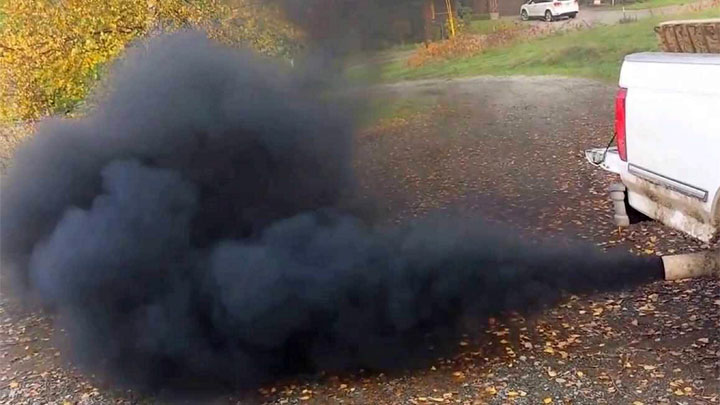
As previously mentioned, a faulty coolant temperature sensor that has defaulted to a permanently cold reading will typically cause an engine to over-fuel (aka: run rich). As a result, excess unburnt fuel is passed downstream, where it often ends up entering the exhaust system.
When this excess fuel burns within a vehicle’s exhaust system, dark grey or black colored smoke is produced as a byproduct. In severe cases, this smoke can become very dense, and quite noticeable to anyone nearby.
#4 – Engine Overheating
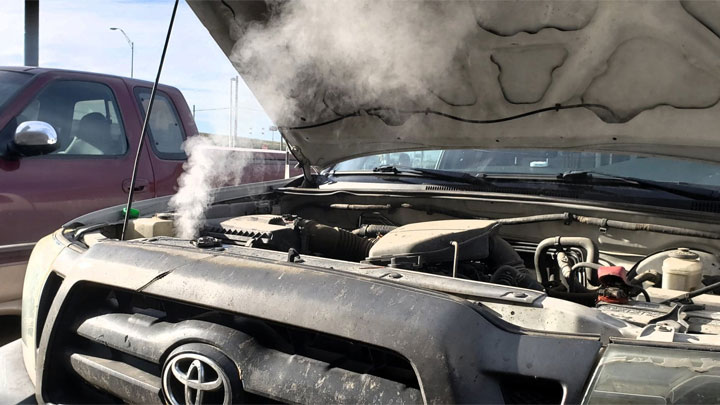
One of the most severe symptoms of coolant temperature sensor failure is engine overheating. While some vehicles utilize an auxiliary temperature sensor to regulate fan operation, the vast majority of makes and models rely upon the engine coolant temperature sensor to sustain this function.
If an engine coolant temperature sensor of this type fails, it is common for the vehicle’s radiator fan to be inoperable. As a result, engine temperatures begin to spike, risking damage to other components.
Related: Losing Coolant But No Visible Leaks? (Here’s What it Means)
#5 – Hard Start at Certain Temperatures
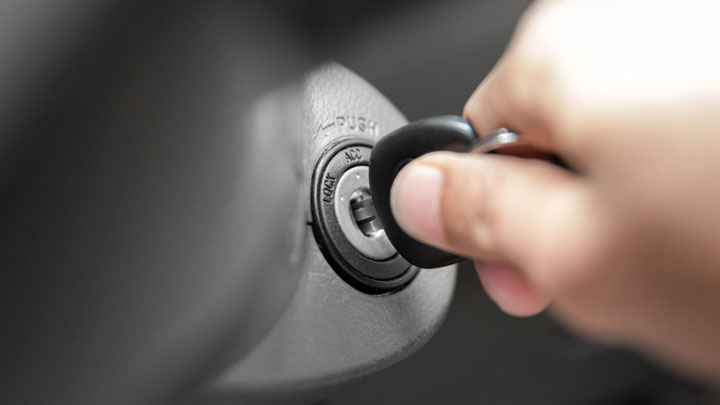
Though not as common as other symptoms, a hard start condition is occasionally presented by a faulty coolant temperature sensor. In most cases, this condition will present itself only when a vehicle’s engine is at one particular temperature, whether hot or cold.
On most occasions, this is the result of a sensor which is providing a continually hot reading, even when an engine is actually cool. As a result, this typically renders a lean condition, which exponentially increases crank times.
Engine Coolant Temperature Sensor Replacement Cost
Best places to order parts? See: 19 Best Online Auto Parts Stores
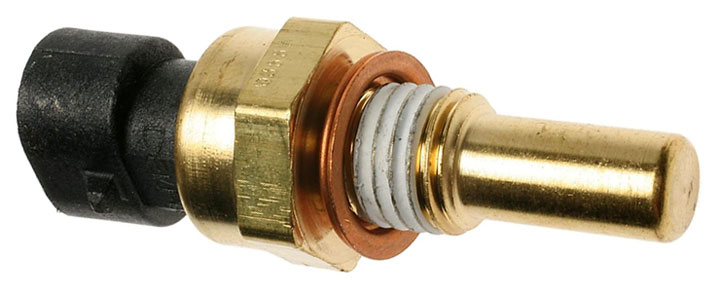
The cost associated with coolant temperature sensor replacement can vary significantly from one model of vehicle to the next.
While the coolant temperature sensors found on many vehicles are relatively simple to replace, others can be quite difficult to access. The actual cost associated with the purchase of a coolant temperature sensor can also vary by vehicle.
On average, the cost of a coolant temperature sensor ranges from $20-$80, while the cost of labor ranges from $50-$250. In total, one could expect to pay $70-$330 to have their engine coolant temperature sensor replaced.
Can You Drive With a Faulty Coolant Temp Sensor?
While a vehicle with a faulty coolant temperature sensor can often be driven from one location to the next, doing so is not advised. With time, many of the individual symptoms of a failing coolant temperature sensor can become problematic themselves.
An inoperable fan caused by a faulty coolant temperature sensor will quickly result in engine overheating. As a result, additional problems, such as head gasket leaks, can arise.
Likewise, abnormally high fuel rates caused by skewed data from a faulty sensor, can lead to the superheating and failure of a vehicle’s catalytic converter.



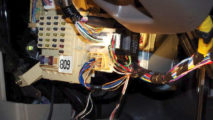
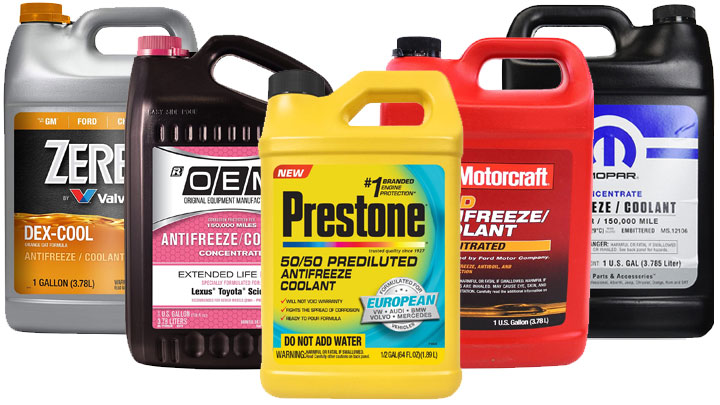
My camry 1994 model is raising idle speed when the coolant sensor is connected. When I disconnect the idle comes down but engine idling becomes erratic. What could be the problem?
Got the same problem on altezza 3sge dualbeams
like your information
Thanks Samuel, glad you enjoyed it.
I’ve replaced several sensors and still have these 5 systems, just ordered it hope it fixes my issues finally, thank you so much for your details of exactly what my car is doing.
Have a 2006 audi s4 with the 4.2 v8 engine . The car runs fine at cold start up and once it warms up it throws a code 0300 , 0301, 0304, 0305 , and 0308 and 0431 and 0421 cat effitioncy bank 1 and2 would the coolant sensor cause all these codes if it’s bad ?
That is a lot of misfires. I highly doubt the coolant temperature sensor would cause this. A bad coolant temperature sensor will often throw a single code, and it’s probably not going to be a misfire.
That sounds more like an issue with the fuel or ignition systems to me. Check to make sure you’re running the correct fuel and make sure your ignition coils are good.
In my 2003 Camry, my car would randomly shut off while driving(only while slowing down to a light) and a the code p0118 would appear. I replaced the thermostat sensor first, then alternator and battery as a mechanic suspected that could do it. (Battery was bad and was under warranty). Was still happening, replaced the thermostat and after a week the engine light came on and and shut off twice, but hasnt happened for a month or two.
The temperature gauge will say -40C(which indicates either a faulty wire or computer) when driving when suddenly it will start working again and say the temperature is 90C (which it should be) after a few minutes of driving the temp will say -40C again. question is, it would not be a faulty wire as that would make it stay at -40C correct? so it would have to be something with the computer? correct?
Sounds like a bad wire or ground. A bad coolant temperature sensor shouldn’t cause your car to shut off like that. Check the wiring that is shared between the fuel injectors and the coolant temperature sensor. Perhaps they share a common ground, or you may find an obvious short or problem with the wiring.
2015 Buick Enclave, I have had a myriad of issues lately with the most irrigating being the a/c when engaged the button blinks 3 times and doesn’t turn on the a/c. Research indicates coolant temp sensor that I have replaced with the same result. Further research states an ignition switch can cause problems with accessories too. It is a quick repair and cost $35 or less pending the type. I did replace it along with swapping out 2.5 year old battery for a new one. This did remedy intermittent voltage spikes to the ignition coil and the engine is running smoother but the a/c is still failing at times. When it does work, it will run you out of the car but the intermittent failure gets old quick here in Houston Texas. Any thoughts to a remedy for this issue? I have heard to check cabin filter and possibly evaporator issues, let me know what you think.
My 2015 Chevy Traverse has these symptoms. However, the fan kicks on randomly, and stays on. My question is… if the heat shield has been removed from the wires, can the wires get fried and result in a faulty coolant temp sensor?
Generally a bad coolant temperature sensor throws a code. Do your fans kick on while you’ve been idling for a while? That is completely normal. There’s no airflow across the radiator so the fans have to do the job when you’re not moving forward.